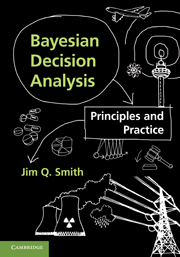Book contents
5 - Bayesian inference for decision analysis
from Part I - Foundations of Decision Modelling
Published online by Cambridge University Press: 05 June 2012
Summary
Introduction
In the last section we considered how domain knowledge could be expressed probabilistically to provide the basis for coherent acts. We now turn our attention to how the Bayesian DM can draw into her analyses evidence from other sources and so make it more compelling both to herself and an external auditor.
In many situations factual evidence in the form of data can be collected and drawn on to support the DM's inferences. We have seen several examples already in this book where such evidence might be available. It is important to accommodate such information on two counts. First by using such supporting evidence the DM herself will have more confidence in her probability statements and will be able to explain herself better. We saw in the previous chapter that probabilities can rarely be elicited with total accuracy. By refining these judgements and incorporating evidence from data whose sample distribution can be treated as known the DM can help improve her judgement and minimise unintentional biases she introduces. Second if she supports her judgements by accommodating evidence from well designed experiments and sample surveys, generally accepted as genuinely related to the case in hand, then this will often make her stated inferences more compelling. Although expert judgements about the probability of an event or the distribution of a random variable are often open to question and psychological biases, it is usually possible to treat data from a well-designed experiment as facts agreed by the DM and any auditor.
- Type
- Chapter
- Information
- Bayesian Decision AnalysisPrinciples and Practice, pp. 131 - 166Publisher: Cambridge University PressPrint publication year: 2010

